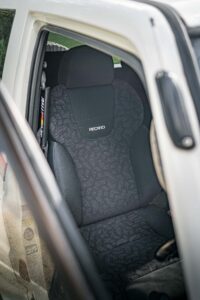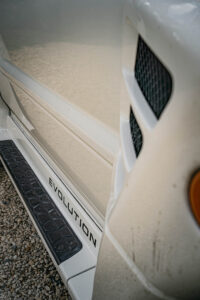You know the Mitsubishi Evo. Cultural icon of the 1990s and 2000s, rally success, deadly rival to the Subaru Impreza, etc, etc. Well, this is a pair of Mitsubishi Evos – just not as you know them.
What most people associate the ‘Evo’ name with is, of course, the Lancer Evolution, an amped-up, homologation special version of Mitsubishi’s humble compact saloon, created to allow them to run competitively on the world’s stage rallies. But Mitsubishi briefly used the Evolution badge on another car, one designed to take on terrain a little more challenging than the muddy forests of Wales or the sun-baked mountain roads of Catalunya.
This is the Pajero Evolution, a car built with one goal: helping Mitsubishi continue their dominant streak in the gruelling Dakar Rally. The Dakar is the most famous example of a rally raid event, a multi-day, long-distance off-road racing discipline that’s a bit like traditional stage rallying on steroids.
All kinds of vehicles participate in the Dakar, from lumbering trucks right down to motorbikes and quads, but it’s car classes that tend to attract the big manufacturer involvement. For years, the race was utterly dominated by the Mitsubishi Pajero. If you’re British, you’ll know this car as the Shogun. If you’re in a Spanish-speaking country, you’ll be wondering why we’ve just insulted you, and you’ll know it as the Montero.
In total, the Pajero won the Dakar 12 times between 1985 and 2007, with the final seven of those victories being consecutive. Until 2002, Mitsubishi ran in the T2 class, which was strictly for production-based cars. And what do you get when a manufacturer wants to eke out advantages in a series for production cars? You get a homologation special.
To create the Evolution, Mitsubishi took a standard three-door Pajero, and effectively completely reengineered it. The base car’s fairly agricultural suspension setup was canned in favour of a fully independent double-wishbone arrangement. The entire chassis was stiffened so the car wouldn’t split in half if launched off, say, a sand dune the height of a medium-sized apartment block.
The engine was Mitsubishi’s 6G74 3.5-litre V6, equipped with MIVEC variable valve timing. It claimed a 276bhp output. Conveniently, this is the exact figure that all the Japanese manufacturers agreed to cap their power outputs at during the 1990s – in theory anyway. Like plenty of other 1990s Japanese performance heroes, it’s widely agreed that it produced more – something around the 300bhp mark.
Manual or automatic gearboxes, both five-speeds, were available, with the manual a far rarer choice. Given that the car was designed to be flung at faintly terrifying speeds towards towering dunes, there are some proper off-road goodies at play – Torsen limited-slip diffs on both axles (it’s four-wheel drive, natch), and a locking centre diff.
It wouldn’t be a homologation special without some outrageous visual addenda, and the Pajero Evo delivers here, too. There are seriously beefy box flares to accommodate the long-travel suspension, widened track and chunky off-road-biased tyres. A big bonnet scoop allows the V6 to breathe a little easier, but the most notable feature is that bizarre rear spoiler that encircles half of the car’s rear profile and flows into two points at its apexes, like the ears of a big, angry cat.
Did all this help Mitsubishi with its competition goals? Yes. And then some. The Pajero Evo made its debut at the 1998 Dakar, and swept the top three positions – not just in class, but in the whole rally, finishing ahead of more specialised T1 class machinery. The Evo only missed out on the top spot by 33 minutes the following year – a small margin in an event that the winning Schlesser Buggy took 70 hours to complete. Its career was over by 2000, a new competitor based on the then-new-shape Pajero introduced.
It won’t have escaped your notice that there’s not one, but two, Pajero Evos here, both identically specced in Scotia White with ’90s-tastic side decals – a factory option – and period-correct OZ Racing rally wheels. They’re owned by the rally-obsessed family unit of Steve, Vicky and son Max, as well as their cohort of dachshunds.
Steve once worked for Prodrive when they ran Subaru’s world rally effort, but the family allegiance lies with their fierce rivals on the stages – as well as the pair of Pajeros, they own two Lancer Evolutions, including a desirable Evo VI Tommi Mäkinen Edition.
Steve explains that he’d always had a desire for the lesser-known Evo after seeing one owned by a neighbour, and he leapt at the opportunity to get his hands on one. “And then it snowballed into two,” says Vicky. “I wanted a kitchen, but that’s my kitchen sat there.”
“They were completely standard,” Steve tells us. “Gradually, I got the wheels and the stickers.” Naturally, these things aren’t easy to source – one set of wheels came from California, the other from Spain. There’s one other key modification very particular to this pairing: Steve is a wheelchair user, so both Pajeros have been adapted with hand controls.
“You have fanatics come up to you at shows saying, ‘oh my God, I’ve never seen one of these before’,” says Max. “They’re one of those cars where if you know, you know,” continues Vicky. “Some people don’t even bat an eyelid, but it gets a lot of attention from others.”
What are these big beasts actually like to drive? “You can drive it over a ploughed field faster than anything else,” says Steve. Max tells us that “UK roads don’t really do it justice – if you were to take it into the sand dunes, or into the snow, it’d be awesome.”
A few years ago, tidy Pajero Evos – don’t forget, a proper homologation special and bearing one of the most storied names in rallying – could be picked up for comfortably less than £20k. That’s not the case anymore – since summer 2022, two have appeared on a well-known online auction site, both clean but high-mileage white examples, and both sold in the mid-twenties.
Values are only going one way, too, with the first Pajero Evos becoming eligible for US import in 2022 under the 25-year-rule. This is something that’s having a knock-on effect on values across the Japanese car scene every year, the Stateside appetite for forbidden JDM fruit only growing more voracious. With no such age restriction on imports to the UK, Evos have been trickling their way over from Japan for years, but they remain rare beasts here. Bearing that in mind, would Steve, Vicky and Max add a third to their collection?
“Yes,” reply Steve and Max in unison (Vicky stays resignedly quiet, that kitchen slipping further away as we speak). “We want a red one,” says Steve, “but they’re like rocking horse s***.”
That’s an idiom that could apply to the Pajero Evo as a whole, quite frankly. With only 2500 built, the minimum required to satisfy homologation rules, it’s rarer than a great many of its more famous Japanese contemporaries. It was an outlier in the 1990s, and even now, when the concept of a performance SUV is far more ubiquitous, but also homogenous, it stands out as a completely different take on the formula. For Mitsubishi, it was a formality, something that enabled them to build a more competitive race car, but for a growing, fiercely dedicated fanbase, it’s a hero. And, unlike the more famous Evo, which had its long-running foe in the Impreza, there is nothing else quite like the Pajero Evolution.
















